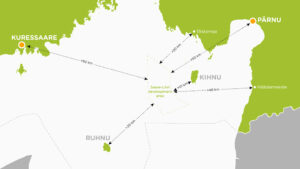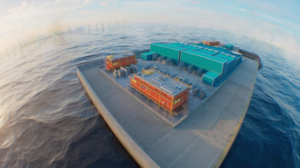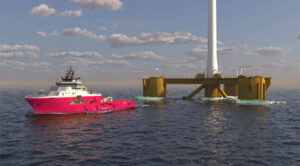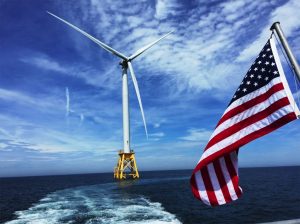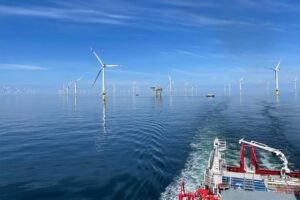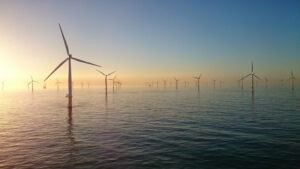Deepwater Wind Resumes Work on Proposed Wind Farm off Block Island (USA)
When the Rhode Island Supreme Court issued a ruling earlier this month upholding a long-term contract for the sale of power from Deepwater Wind’s proposed wind farm off Block Island, it was a green light for the company to resume work on the project.
As the case dragged on for nearly a year, with the outcome uncertain, Deepwater suspended costly geological and oceanographic studies that are crucial to the design and engineering of the five-turbine wind farm.
“When the appeal was lodged last August, we had to completely postpone all the field work,” said company president and chief executive officer William M. Moore. “We lost a year to the appeal.”
Now, the Providence-based company is working in haste to complete a battery of studies that it must submit as part of its applications to the state Coastal Resources Management Council and the U.S. Army Corps of Engineers, the lead permitting agencies for the project that would be located in state waters within three miles of Block Island.
Between now and October, Deepwater will survey the ocean southeast of Block Island where its six-megawatt turbines would be erected in an arc that follows the curve of the island. The company will use side-scan sonar to get a detailed picture of the ocean floor terrain and penetrating sonar to learn more about the geology deeper down where pilings would be driven 150 feet into the ground to hold the turbines’ steel foundations in place.
The company will also survey the sea floor between Block Island and Narragansett, where a 25-mile transmission line will be buried to connect the island to mainland Rhode Island. The cable would travel south from a substation near Narragansett Pier before doglegging toward Block Island to avoid an area of important marine habitat, according to Moore.
Bird and bat surveys that have been under way on Block Island for nearly three years will be completed. And wind studies using a weather data tower on the island that started about two years ago will also be wrapped up.
All told, the work will cost up to $4 million. The permit applications will then be completed and will be submitted early next year.
It’s a tight timeline to keep the project on schedule and to be online at the beginning of 2013, but during a recent interview in Deepwater’s offices off Exchange Terrace, Moore appeared unconcerned.
“It’s definitely manageable,” he said.
Until a resolution was reached in the Supreme Court case, not much could be done on the Block Island project because the power-purchase agreement with National Grid is so vital in securing financing.
Because developing offshore wind power is expensive — Deepwater’s proposal, with the transmission cable included, will cost about $250 million and, because no similar projects have been built in the United States yet, such wind farms are considered a huge risk to investors and lenders.
But Deepwater’s contract with National Grid guarantees a source of income for 20 years, with a selling price that starts at up to 24.4 cents per kilowatt-hour. With the deal now in place, a project that was once uncertain becomes something much more attractive to banks and other financial institutions.
Since the appeal — which was lodged by two plastics companies that objected to the high price of power in the contract — was turned away, Deepwater has been contacted by multiple investors, said the company’s chief development officer Jeffrey Grybowski. He characterized the response as “substantial interest.”
The project will probably be financed in a 60/40, debt/equity split. D.E. Shaw, a global-investment and technology-development firm with approximately $21 billion in investment capital as of July 1, remains a key backer.
“They’ll be responsible for a major portion of the equity,” said Moore, adding that there will be other equity investors.
Much of the financing, however, won’t be tied up until Deepwater receives its permits from the CRMC and the Army Corps. The company will also need secondary approvals from a host of other agencies, including the state Department of Environmental Management and the federal Bureau of Ocean Energy Management, Regulation and Enforcement.
Moore declined to speculate on how long it would take the various agencies to assess Deepwater’s proposal.
“I don’t want to presume anything,” he said. “This is the first time through for them on this type of project.”
In the meantime, Deepwater will continue to work on plans for developing 117 acres in North Kingstown’s Quonset Business Park, where the Block Island wind farm and potential projects, including a 200-turbine array in Rhode Island Sound, would be staged. An engineering study of the land, as well as connecting roads and piers, is being done in conjunction with the Quonset Development Corporation, the state agency that manages the business park. Deepwater is also completing a deal with a turbine supplier. The agreement with the company, which Moore describes as “one of the leading suppliers in the world,” is expected to be announced in the fall.
Despite the yearlong delay for the project, Moore remains upbeat. He said there was an unexpected upside. The company has been able to collect more wind data, which, it turns out, may bolster the wind farm’s chances of reaching fruition.
“The wind resources look even better than we thought at the outset,” Moore said.
By Alex Kuffner (projo)
[mappress]
Source: projo, July 29, 2011;


